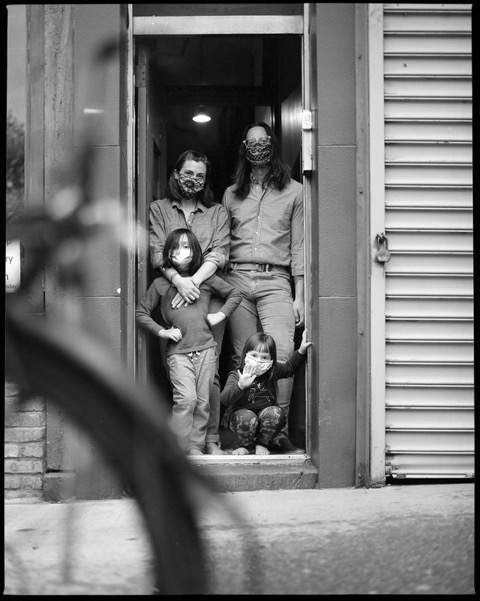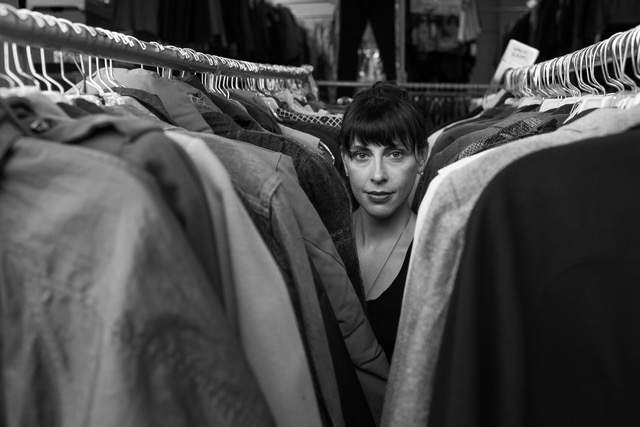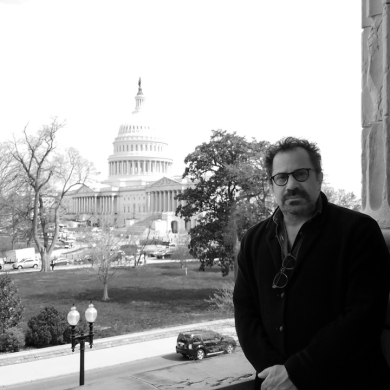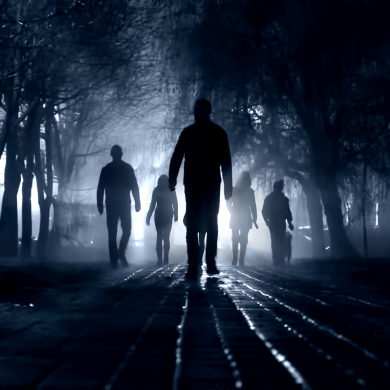Published Date: 05-13-20
By Justin Sanders
[All photos by Kent Meister]
Much has changed in the world since we spoke with Katie Irish in June of 2018. Back then, Irish had just wrapped up the job of lead costume designer on FX’s acclaimed series The Americans – and was looking toward the future with both excitement and trepidation.
“It was a dream job across the board and it makes me nervous about what comes next,” she told us at the time.
Today, as creatives everywhere struggle to subsist and stay sane amidst historic, industry-wide shutdowns, those words feel especially prophetic – but Irish has found ways to stay busy and upbeat during the pandemic. She has worked steadily since The Americans wrapped – including as costume designer on NBC’s The Enemy Within – and was shooting a new series for Netflix in Tel Aviv when the outbreak began in the U.S.
“We only flew back to New York on March 14,” she tells us. “Since then, I have hung up my hat as a costume designer and become a kindergarten and preschool teacher [for my two young children]. We all do art projects together, which I love. I actually just did my first watercolor that was completely unrelated to work since I was in grad school. I’ve also been assigning myself pretend designs to do so that I can continue to improve my skills sketching on the iPad.”
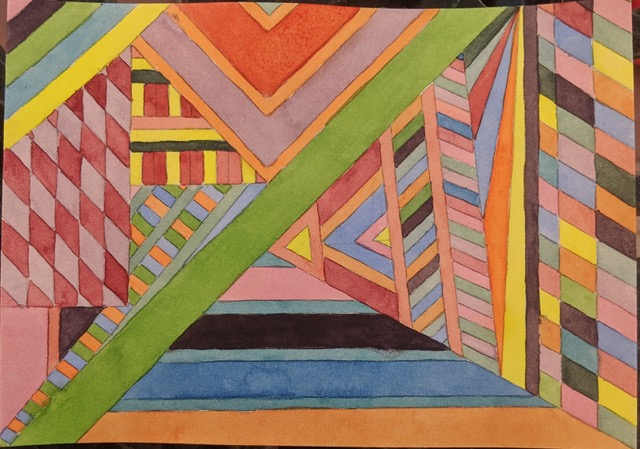
Painting by Katie Irish
“Otherwise, I’ve been staying involved with my community of designers and other industry professionals,” Irish continues, “who have been acting as sounding boards and cheerleaders for each other. None of us knows how this will ultimately affect our profession.”
Though the times we live in are frightening and unprecedented, there has been at least one bright spot for Irish: “I have never had the opportunity to spend this much time with my family,” she says.
We salute Katie Irish and all creatives in our community as we navigate these uncharted waters. Read our original interview with her below – and, as always, #StandCreative.
From June 27, 2018.
With its retro-cool ‘80s Cold War backdrop and ongoing parade of character disguises, the now wrapped FX thriller The Americans would have been a fantastic gig for even the most seasoned of costume designers.
For Katie Irish, it was her first job as a lead costume designer in television.
“It was a dream job across the board and it makes me nervous about what comes next,” she told CreativeFuture, talking by phone from her home in Brooklyn, just blocks away from the stages where The Americans shot throughout its six-season run. “But I have to believe that if I’ve had this one dream job that there are others out there, too, just waiting.”
Irish’s journey toward creating the outfits for superspies Elizabeth and Philip Jennings began in the theater world, where she worked as an associate costume designer on Broadway shows such as Jesus Christ Superstar, Godspell, and Spider-Man: Turn Off the Dark.
After deciding that film and television would offer a more stable creative life and allow her to have a family, Irish started calling people she knew in the business, saying, “‘I will do whatever. You need a PA, I will be a PA. I will go get people coffee. I’m happy to do that to get a foot in the door.’”
She wound up finding work as a shopper for a two-day Americans background shoot, and never looked back.
“I love being able to tell you who a person is before he or she even opens their mouth,” Irish said. “It’s something that not everyone watching can necessarily put into words, but you get a feeling for who a person is through the costume design.”
Justin Sanders: Where did you grow up? Were there any signs as a child that costume design might be in your future?
Katie Irish: I grew up in Memphis, Tennessee, and no – there were no signs that I would one day become a costume designer. I didn’t really play with dolls and I didn’t play dress-up. I left that to my sister.
I did do school plays starting in seventh grade and had a wonderful time with that – but believe it or not, I actually was a science geek and was pretty sure I was going to be a research biologist.
I went to the University of Tulsa as an undergrad and, in my first semester, I took a biology course and quickly discovered it was not something that was going to drive a lifelong passion.
Fortunately, I had applied to Tulsa because they had an excellent biology program as well as a fantastic theater program, [laughs] which is actually a hard combination to come by.
What was so fantastic about Tulsa’s theater program?
Everyone had to direct, everyone had to stage manage, everyone had to design, and everyone had to act. It didn’t matter if you were any good at it – you had to do those classes so that you understood what the collaboration needed to succeed.
I thought that was invaluable.
At what point did you start to focus on costume design?
I didn’t take a costume design class until first semester of my junior year. It was with a fantastic professor, who is still my mentor to this day, and I really had one of those Eureka! moments where the heavens open and angels sing. I realized that this was my calling – this was what I needed to be doing.
What was it about costume design that made you feel that way?
I love being able to tell you who a person is before he or she even opens their mouth. It’s something that not everyone watching can necessarily put into words, but you get a feeling for who a person is through the costume design.
For example, let’s say a character comes in wearing a black t-shirt and jeans. That sounds simple enough but depending on if that character bought that black t-shirt and jeans at Old Navy, or if they bought them at Barney’s – they could be two very different people, even though they’re wearing the exact same clothes.
For me, it was really exciting to be able to shape and mold a character in that way, and to work so closely with the actors to bring something to life.
What was your first paid costume design job?
The professor who was my mentor ended up taking a position at a different university right after I graduated from Tulsa. They needed someone for a year to serve as an interim costume designer and costume shop manager – and there I was.
It was a really great experience for me because it bridged the gap between a professional life and academia. I was getting paid to design five mainstage shows in one year, but it was also with a group of people that I had known in the academic world, so there was a bit of a safety net.
What happened when the year was up?
I knew I desperately needed some additional training and that I wanted to work in theater. To my mind, New York was the center of that, and so the only place to go to graduate school would be in New York.
So, I applied to New York University and was accepted and did three years of grad school there. Then I just started working. My first job was as a non-union shopper on a theater production called White Christmas that one of my professors was designing.
Is being a shopper for a costume department as fun as it sounds? The job description seems to be, “Go out and buy cool stuff with the company credit card.”
When you put it like that – yes, it really is taking other people’s money and going out and buying things. But, those things can be as mundane as 42 pairs of black, gold-toed socks. It’s not always exciting things.
Also, in New York, you might be out in a blizzard, shopping and carrying bags when it’s 12 degrees and snowing. You’re also under the gun to find the exact right thing, which is a lot of pressure, and sometimes, especially in television, you have four or five hours to do it. It can be very stressful!
So how did you make your way from non-union shopper in the theater world to wanting to be in television?
I eventually got work as an assistant designer then as an associate designer on Broadway. I was also doing some of my own work regionally in opera and dance and theater.
I did all that for about 10 years, and then I realized that I was working six days a week for a flat fee, that my day off was a day that very few other people had off outside of the theater community, and that I wanted to have a family and have some time to spend with my husband.
Also, in addition to the lifestyle changes I craved, I really believe that what I do with costumes is summed up in the small choices that make up these characters. Costume design is not a big brush stroke – the earrings that someone is wearing coupled with the stitching on a blouse can really start to tell you who a person is. Those kinds of small details get lost in theater.
So, I decided that I needed to be working in film and television.
Once you made that decision, how did you go about breaking into film and television?
I called people that I knew and I said, “I will do whatever. You need a PA (production assistant), I will be a PA. I will go get people coffee. I’m happy to do that to get a foot in the door.”
I had a friend who was working with a designer on a film and they needed a shopper in New York. I did two weeks of shopping for that film, and then about a year later, the same designer was working on a brand-new television show called The Americans, and they were having a big background scene and needed an additional shopper for two days.
This was in January of 2013. I came for two days, and then I just never left. I worked as a shopper for that first season, and really got to know the show and who was there and what we were doing. After the first season, the assistant designer was leaving for another show, and she asked if I would be interested in stepping into her role. I said, “Of course.”
Given that you were still relatively new to television, that seems like a pretty quick promotion. Was the adjustment to television easier than you thought it would be?
It was definitely a learning curve. Ultimately, though, being an assistant costume designer for television was the same skillset as what I had been doing in theater. You’re still doing all the budgets, overseeing the workspace, and executing the head designer’s vision.
How long did it take for you to ascend to lead costume designer?
I worked on the second and third seasons as assistant costume designer, and meanwhile, would do other work when The Americans went on hiatus. I did two independent features. I dressed contestants on America’s Got Talent. Then, towards the end of the hiatus on the third season of The Americans, the show’s current costume designer called and said she wanted to go back to doing feature films – would I be interested in taking over her position?
I said “of course” and once again, my name was put forward and I got the job.
What are the primary duties of a costume designer on a television drama, day in and day out?
Well, one of the things I like best is that every day is different for a costume designer, but largely, my responsibility is to read the script and to work with the actors, the writers, the director, and the producers to put together clothing that accurately tells the story that we all want to tell. Whether that means that I am buying all the clothing, or making all the clothing, or some combination of the two – I serve the story.
Break that down for us – what was the process of translating the script for each Americans episode into costumes that served the story?
Before each episode of The Americans, I would read each script twice before we had our first meeting, which we called the Concept Meeting. It included all the department heads, the script’s writer, and the director – and we would just talk about the overarching ideas for that episode.
Then we would have a costume meeting where we went through the given script page by page and noted details such as whether a scene occurred at night, and if the characters in the scene were in bedclothes. Or maybe they had just come home from work and were in work clothes but had loosened their collars and rolled up the sleeves – things like that.
After that meeting was when I would send out shoppers to go and find the outfits that we needed. If we were building something from scratch, I would send them to the garment district to get fabric.
Sometimes we would need multiples of the same costume for a stunt sequence. In that case, we would do some online shopping – because it’s very hard to lay your hands on eight of anything, which is often what we would need for both the actor in the scene and for their stunt double.
Then it would be time to do fittings and begin to put everything together. For any one look that someone appeared in, I would usually have at least four options. Then everybody would weigh in on what the choices were and we would pick one and it would go into alterations.
Then we would do it again for the next person.
You would do this process for every outfit, for every character, in every scene, for every episode?
Yup.
Wow. That’s a lot.
Yeah, it’s a ton. There were a lot of fittings.
At the beginning of each season, we did have what I called “closet fittings” for our series regulars. Those were three- or four-hour fittings where we would just try and slam through as many options as possible and send over 35 to 40 different outfits and six different coats, and things like that.
So, then I would have an entire closet that had been approved for, say, Elizabeth Jennings’ character – though that didn’t negate the fact that we still had to do all the disguises and other elements that were specific to each different episode.
How much did you learn about spy craft during your time on the show?
You know, I feel like I know a pretty good amount at this point. [Co-Showrunners] Joe Weisberg and Joel Fields were adamant that all the spy craft was accurate, so everything you see on the show was actually done by either the KGB or the FBI. We did not invent any of it for the show.
There was a New York Times article last year about a spy who was caught in Russia who had $30,000 in cash, and a blonde and a brown wig in a bag. [Laughs] Immediately, I was thinking, “Really? You kept your wig in your bag? That was your first mistake right there!”
Did you develop more of an appreciation for ‘80s fashion while on the show, or were you sick of it by the end?
A little of both. When you say 1980s, everyone thinks of Dynasty, Madonna, the enormous shoulder pads and the big stripes of blush and the big hair and the men’s suits that are very boxy. It’s been really interesting for me to find the beautiful parts of the ’80s that were there throughout the entire decade as well.
I’ve very much enjoyed going back and finding the beautiful silhouettes and the gorgeous fabric for men’s suits. But I’ve also been living in the ’80s for the past six years, so I will be happy to move along to a different era.
All things considered, though, The Americans seems like an amazing get for your first gig as lead costume designer.
It was absolutely a dream job. It was a period show and there were disguises on top of it! I had the nicest group of actors to work with, too. They were willing to wear things that they would never have personally worn in their real lives. There were times, especially with stars Keri Russell and Matthew Rhys, when they needed to look less attractive than they do in real life – to blend in a little more or be downright homely as part of a disguise. And they were game for it, which was huge.
On top of that, I had an amazing crew that worked with me, and my direct bosses were always open-minded. If I really needed to, I could have called Joe and Joel at 10:00 PM and they would have taken the call.
It was a dream job across the board and it makes me nervous about what comes next, but I have to believe that if I’ve had this one dream job that there are others out there, too.
What do you think your next dream job would look like, having had such a great experience on The Americans?
I am open to anything with good characters that tells a good story, in either television or film.
I’ve been spoiled. Even after all of the long meetings and all of the fittings and reading all of the various script updates and watching the dailies and being on set – I still liked watching The Americans on TV. Working on something that intensely and still actually being engaged in the story is a remarkable thing.
Ideally, I work on something next where I feel equally as engaged with its story.
What advice would you have for someone who is interested in becoming a costume designer?
If you’re still in school, take any and all classes that interest you. Don’t just limit yourself to costume design classes.
Case in point – my freshman year in college, we all had to take a seminar that was not relevant to any specific major. I took History of the Cold War and that class has been more useful than almost any other class I’ve ever taken because I still had all my notes when I got hired on The Americans.
If it interests you, take it. You never know when it might become useful.
Past that, if you are interested in working in film and television, figure out how to be a PA on a set. That is by far the best way to meet people, to gain an understanding of the hierarchy of sets, and also to really figure out if you want to be in costumes or in wardrobe. Those are different departments.
What is the difference between the two departments?
Costumes is the design side of it. We are in all the meetings. We do all the fittings. I get everything creatively designed and ready to wear. Wardrobe is the people who are on set, the people who make sure that for, say, Scene 25, you are wearing the correct outfit. They’re the ones that makes sure everything is clean or, if it’s meant to be that way – dirty. They’re the ones who make sure everything looks the way that it should.
What kinds of skills does one need to do your job? Do you have to be a great sewer?
I know costume designers who are not able to sew in the least. I do know how to sew and I think it is very valuable because even if I can’t do it very well, I still have an idea of how things go together, so when I’m talking to my tailor I know if I’m asking her to do something absolutely insane.
Drawing is a skill that comes in handy as well. There are a lot of people in this line of work who draw exquisitely. [Laughs] I am not one of those people. I wish I were. I have friends from grad school whose renderings I would happily hang in my house as art, but mine are very functional.
If you, like me, don’t have that drawing skill, there are definitely other ways to get your ideas across. I do these research boards that have collages and sketches and fabric all mixed together to give as much of a complete picture as I can. On The Americans, I found that those boards were the best way for me to get across ideas and convince people that, yes, other people really were wearing these things at that particular time and I’m not being crazy with the ‘80s aggressive shoulder pads and things like that.
It’s just about communicating as clearly as possible what your intentions are. You don’t want any surprises in television. The timeline is so fast that you really don’t want to end up the night before with people looking at the final fitting and going, “Oh, that’s not what we thought it was going to be.”
You want them to say, “Yes, Katie. We saw it. We know. This looks good.”
Photos courtesy of Katie Irish

